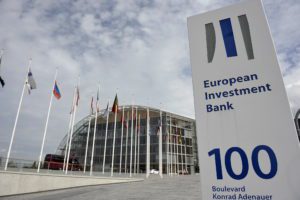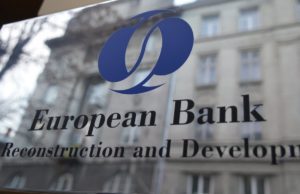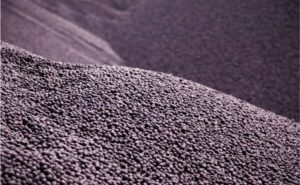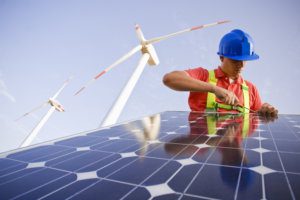
The European Bank for Reconstruction and Development (EBRD) in 2020 reduced investments in Ukraine to EUR 812 million in 34 projects compared to 2019, when the Bank invested 51 projects for EUR 1.1 billion.
“In terms of annual investment, Ukraine ranked third among the Bank’s countries of operation after Turkey and Egypt,” the EBRD said in a press release.
According to it, new investments included support for projects to improve corporate governance (as a pilot transformation program for Ukravtodor), as well as a project for transforming Ukrposhta, improving transport infrastructure in Ukrainian cities, introducing energy efficient technologies in heavy industry, etc.

The European Bank for Reconstruction and Development (EBRD) has approved the issuance of a EUR3 million loan to PrJSC Lantmannen Axa, a breakfast cereal producer in Ukraine.
“The project will support improvements and expansion of production lines and higher value-added products, which is expected to lead to improvement in profitability and efficiency,” the EBRD said on its website.
“Out of the total investment plan of the borrower, EUR1.09 million is planned to be used for modernization of the production lines and installation of automation and control systems, which is expected to lead to energy efficiency savings,” the report says.
Lantmannen Axa is part of the Scandinavian food concern Lantmannen, which supplies products to 45 countries.
Lantmannen’s annual turnover is more than $3 billion.
Lantmannen Axa is a large Ukrainian producer of breakfast cereals. At its factory in Boryspil (Kyiv region) it produces goods (granola, cereal bars, cereals) under the START and AXA brands.

The European Bank for Reconstruction and Development (EBRD) invested EUR1.1 billion in 51 projects in the public and private sectors of Ukraine in 2019, EBRD Senior Adviser for External Affairs Anton Usov has said.
“Last year, among the countries of EBRD operations, Ukraine ranked second in terms of investments and first in the number of signed projects. Some EUR680 million of the total investment in Ukraine in 2019 was assigned to the “green” category [projects with an environmental component], which is the highest figure among all EBRD countries,” he said on Facebook.
The EBRD is the largest international financial investor in Ukraine. Since the beginning of its activity in the country in 1993, the bank has financed 445 projects for a total amount of almost EUR14.6 billion.

Canada’s Black Iron, implementing the investment project to create a new iron ore production facility in Kryvy Rih (Dnipropetrovsk region), has said that it received expressions of interest from European banks and export credit agencies to provide $250 to $300 million of debt.
The company said in a press release that Black Iron management continue to make sound progress arranging the financing for Shymanivske project construction.
Construction of phase one to produce four million tonnes per year of 68% iron content pellet feed is estimated to cost $436 million, as further detailed in Black Iron’s most recent Preliminary Economic Assessment. As is typical for financing the development of mining projects, based on discussions with potential investors and financiers, the company estimates that some $175 million (40%) will be equity and the balance around $261 million (60%) financed as debt, not including financing charges and working capital.
Black Iron CEO Matt Simpson said that strong interest from well known, highly regarded, providers of debt financing for project construction is seen.
“The indicative interest rates, grace period prior to starting repayment and loan duration in the expressions of interest received by the Company are very competitive. The recent announcement of the MOU between the Company and Ukraine’s government to transfer a critical parcel of land to the Company is an important milestone that both anchor offtake and debt investors have been waiting to see. The Company is currently negotiating binding terms for the land transfer, including the compensation amount, and expect this to conclude following a binding product sale (i.e. offtake) agreement as a portion of the funds invested by the offtake company will be used to cover the land transfer costs. Now that an MOU on land transfer has been reached, we look forward to commercial negotiations for project construction financing being accelerated,” he said.
Majority of the required equity for project construction is anticipated to come from offtake by a large trading company and/or steel mill that is interested to purchase Black Iron’s pellet feed on a long-term contract at a slight discount to market price in exchange for making both a prepayment and acquiring ownership in the Shymanivske project. Several multi-billion companies, including Glencore, as previously announced, are currently conducting due diligence to consider such an investment.
Additionally, there are two Asia based construction companies that have conducted site visits and expressed serious interest to invest up to $50 million of equity in kind in exchange for being awarded the construction contract.
From a sequence standpoint, discussions are being held simultaneously with equity and debt investors as both are ultimately required to fund project construction. It is likely the anchor equity and offtake investor will be announced first followed by completion of an updated feasibility study and environmental impact assessment upon which the debt financing can be secured to allow for construction start around the end of next year, the company said.

The European Bank for Reconstruction and Development (EBRD) is about to invest from $2 million to $4 million in the development of infrastructure of auctions stimulating renewable energy, EBRD Deputy Director in Ukraine Marina Petrov said during her interview to the Reform.Energy website. “This is the money that we are already asking for now from the donors in order to launch a high-quality auction,” she said. She explained that market players might not be able to perceive poorly organized auctions. “This is very important to keep up the balance of interests in order to receive the most outstanding result,” Petrov said. The auctions will have to be transparent, understandable and in line with legislation.
According to her, the EBRD during Ukraine’s transition to the auctions stimulating renewable energy is ready to share its experience from similar auctions in those countries which were the first ones to introduce such tools. Such or similar auctions are held in Turkey, Poland, Bulgaria, Jordan, Egypt, and Armenia, she said.
The amount is to be allocated within the EBRD’s USELF-III lending facility approved in July this year in the amount of EUR 250 million to support private renewable energy projects in Ukraine, she said.
Speaking at the Ukrainian Financial Forum organized by the ICU Invest Group in Odesa, the EBRD representative said that market operators had questions as for who would be a balancing player on this market. She said that the EBRD was working jointly with the U.S. Agency for International Development to create the market of balancing facilities and invest the funds in more mobile parts of the system, e.g. batteries, gas turbines. “This is next year’s agenda,” Petrov said.
In general, she described the situation on the renewables market as a “quick sprint” – the investment is to be made while the current feed-in tariffs are in effect.
“We’ve got many investors who are mulling over investment this and next year. We have fewer investors who are preparing projects for 2020-2021. We see there will be a steep decline,” she said.
In this connection, she called on the adoption of a law on renewable energy auctions by the end of the current year.
Ukraine has great potential for the development of other sectors of renewable energy, mainly biofuel and small hydro facilities, she said.
DEVELOPMENT, EUROPEAN BANK, INVEST, RECONSTRUCTION, RENEWABLE ENERGY